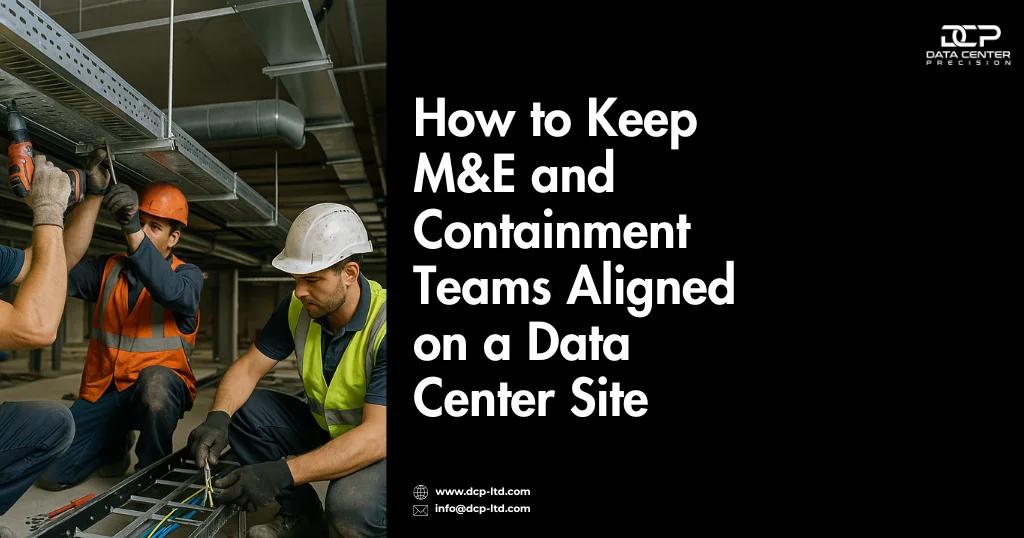Insights

How to Keep M&E and Containment Teams Aligned on a Data Center Site
On a large data center built in the Southeast, progress was steady until it wasn’t.
The containment trays were installed before the ductwork arrived. The ducting couldn’t be adjusted without removing sections of the tray. Electrical teams were waiting for clearance that hadn’t been confirmed. Work had to stop. Rework began.
This wasn’t a case of poor workmanship. It was poor coordination.
Keeping mechanical, electrical, and containment teams aligned on a data centre site is not just a good idea; it’s necessary. Here’s how to do it properly.
Problems begin when teams assume they know the order of work.
You need to confirm the sequence early. Agree as a group. Bring all discipline leads into the same room, with a plan on the table. Talk it through, zone by zone.
Once agreed, issue a written version. A visual matrix showing who installs what, and when, works well. Update it as needed, and reissue formally. Don’t rely on verbal updates or notes in WhatsApp groups.
When teams work from different sequences, rework is inevitable.
Do you want fewer clashes and a smoother install programme? We support project teams with on-site coordination, design reviews, and sequence planning.
Walk the Site Together Regularly
It’s not enough to check drawings. You need to walk the site.
Issues on paper often look fine until you’re in the space. Supports may clash. Cable trays may block access panels. There might not be enough clearance for maintenance.
If each trade walks the space alone, they don’t see the whole picture. Joint walkdowns uncover issues earlier and help build trust between teams.
Make it routine. Even a 15-minute walk once a week can save hours of rework later.
Keep One Main Contact Per Discipline
Messages get lost when too many people share them.
Each discipline should have a named lead. That person is the contact for all sequencing, access, and design updates.
It keeps communication clean. It also avoids situations where one installer is acting on outdated instructions because their supervisor hasn’t received the update.
If you're managing the project, this approach makes it easier to hold the right people accountable.
Stick to Agreed Access Windows
It’s tempting to move into a zone early, especially if another team is behind schedule. But doing so often creates more problems than it solves.
If containment is installed before the pipework is complete, there’s a strong chance it’ll need adjusting later. If electrical fit-out starts before ducting is signed off, access might be blocked.
Stick to the programme. Make decisions based on progress, not pressure. Sign off on one trade before the next moves in.
You don’t save time by working early. You save time by working in the right order.
Always Use the Latest Drawings
Rework often comes down to teams using outdated information.
Make sure the site operates on a single source of truth. Only issued drawings should be used. Any markups or changes must be formally recorded and circulated.
Avoid making changes based on phone calls or passing conversations. What seems like a quick fix often creates a longer problem.
If changes are needed, log them, update the drawing, and reissue it. That’s the only way to maintain alignment.
When It Works, It Shows
On a recent project, we coordinated three core trades across six data halls. We held weekly install reviews, issued a clear install matrix, and walked each zone before handover.
There were no clashes. No rework. No missed access points.
That didn’t happen by chance. It happened because everyone followed a clear, shared process and took the time to communicate properly.
Working on a live site where trades are stepping over each other? We help keep mechanical, electrical, and containment teams aligned so your project doesn’t stall over preventable issues.
Interested in working together?
We help project teams keep discipline alignment tight, from planning through to final sign-off.
Whether you’re managing a full build or coordinating a specific package, we can support with sequencing, site walkthroughs, and design clarity so your teams don’t waste time fixing what shouldn’t have gone wrong in the first place.
Visit www.dcp-ltd.com or book a call today.

2 Comments
David Shon
Nam vel lacus eu nisl bibendum accumsan vitae vitae nibh. Nam nec eros id magna hendrerit sagittis. Nullam sed mi non odio feugiat volutpat sit amet nec elit.
Jhon Watchson
Nam vel lacus eu nisl bibendum accumsan vitae vitae nibh. Nam nec eros id magna hendrerit sagittis. Nullam sed mi non odio feugiat volutpat sit amet nec elit.